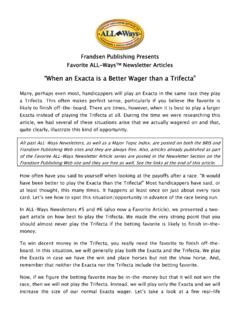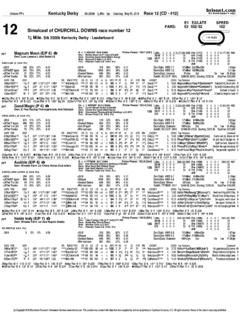Transcription of Premium Plus PPs Explanation - Brisnet
1 Premium plus PPs Explanation Part 1. 1) Bris Pace and Speed Pars: The average pace and speed ratings for the leader/winner of races at today's class level and distance. 2) Run Style Stats: Provides information on: a) The running style of the horse: E (Early) = A horse that exhibits this run style is one typically vies for the early lead or whose best races are run on the lead. Most horses in this category do not successfully rate behind a pace setter. E/P (Early/Presser) = A horse that exhibits this run style is one that runs second or third within a few lengths of the lead early before trying to run down the leader. An E/P horse, just like an E horse, may run on the front end but, unlike an E horse, it can be expected to successfully rate behind a pace setter. P (Presser) = A horse that exhibits this run style is one that runs in the middle-of-the-pack early before trying to run down the leader.
2 A P horse may at times run close to the lead but rarely, if ever, challenges for the lead early. Unlike and S horse, the P horse doesn't typically run from the rear of the pack in its better races. S (Sustain or Closer) = A horse that exhibits this run style is one that runs in the back of the pack early before trying to run down the leader. NA (Not Available) = A horse that is a first time starter or who hasn't had enough meaningful running lines to accurately assess the horse's preferred run style. b) Early speed points. The numbers range from 0-8 and measure the Early Speed ability of the horse based on its running position and beaten lengths at the first call of recent races. The higher the number, the more early speed a horse has shown in recent races. 3) Owner & Jockey Silks: Provides information on who owns the horse as well as the color of the silks the jockey will be wearing in today's race.
3 4) Jockey Stats: Provides information on: a) The jockey's record for the meet (number of mounts, winners, second place finishers, third place finishers, and win percentage). b) The jockey's record for the year (number of mounts, winners, and percentage of winners). 5) Horse's Pedigree, Sales & Breeding Information: Provides information on: a) The color of the horse. B. = bay chestnut Dkbbr. = dark bay or brown Gr/ro. = gray or roan Bl. = black Wh. = white b) The sex of the horse. c = colt f = filly h = horse m = mare g = gelding r = ridgeling c) The age of the horse. d) Month of birth (Two-year old and maidens only). e) The sale at which the horse sold, the year of the sale, and sales price. f) The sire, (the sire's sire) and current stud fee. g) The dam and (the dam's sire). h) The breeder and the state or country in which the horse was bred.
4 6) Trainer Stats: Provides information on: a) The trainer's record for the meet (number of starts, winners, second place finishers, third place finishers, and win percentage). b) The trainer's record for the year (number of starts, winners, and percentage of winners). c) The trainer's record with race angles that pertain to today's race (Number of starts, percentage of winners, and ROI of return on investment for every $ wagered). The statistics in this category cover the last three years. 7) Bris Prime Power Rating: A number that measures the quality of each horse's most recent starts by combining dozens of handicapping factors into one easy-to-use rating. Speed, class, pace, form, weight, distance, and many more factors are combined by a sophisticated algorithm to form this rating.
5 The horse's ranking in this race appears in parenthesis. For more information on Prime Power, refer to the article PRIME POWER USING OUR BEST RATING found in the Library of the Brisnet web site. 8) Medication, Equipment, and the Weight the Horse Will Carry: Provides information on: a) Medication the horse will be using today. L = Lasix, = First Lasix, B = Bute b) Whether or not the horse will be adding or taking off blinkers today. ON = blinkers on, OFF = blinkers off. c) The amount of weight, including the jockey, which the horse will be carrying for this race. If today's jockey is an apprentice, a smaller number will appear immediately to the right of the weight. This is the number of pounds that the jockey gets as a weight allowance for being an apprentice. 9) Horse's Lifetime Start Information: Provides information on: a) Life: Horse's number of career starts, wins, second place finishes, third place finishes, career earnings, and lifetime best Bris speed rating.
6 B) Horse's Current Year Record: Number of starts, wins, second place finishes, third place finishes, earnings for the year, and best Bris speed rating for the year. c) Horse's Previous Year Record: Number of starts, wins, second place finishes, third place finishes, earnings for the previous year, and best Bris speed rating for that year. d) Horse's Career Record at Today's Track: Number of starts, wins, second place finishes, third place finishes, earnings at this track, and best Bris speed rating earned at this track. e) Fst: Horse's career record over fast dirt tracks including number of starts, wins, second place finishes, third place finishes, earnings, and best Bris speed rating earned over fast dirt tracks. f) Off: Horse's career record over wet dirt tracks including number of starts, wins, second place finishes, third place finishes, earnings, and best Bris speed rating earned over wet dirt tracks.
7 G) Dis: Horse's career record at today's distance including number of starts, wins, second place finishes, third place finishes, earnings, and best Bris speed rating at today's distance. h) Trf: Horse's career record on the turf including number of starts, wins, second place finishes, third place finishes, earnings, and best Bris speed rating on the turf. For More information on Bris speed ratings, please refer to the article BRIS SPEED RATINGS found in the Library of the web site. 10) Bris Pedigree Ratings a) The Fast Pedigree rating measures the quality and suitability of the horse's breeding for races run on the dirt. b) The Off Pedigree rating measures the quality and suitability of the horse's breeding for races run over a wet dirt surface. c) The Distance Pedigree rating measures the quality and suitability of the horse's breeding for races run at today's distance.
8 D) The Turf Pedigree rating measures the quality and suitability of the horse's breeding for races run on the turf. For more information, please refer to the article BRIS PEDIGREE RATINGS found in the Library of the Brisnet web site. 11) Denotations for Today's Race: Tells if a horse is: a) AE = Also Eligible for today's race. This is seen when there are more horses entered than can actually start in the race. A horse that is also eligible can only draw into the race if there are scratches. b) MTO = Main Track Only. This designation is seen only in turf races and means that the horse will run only if the race is moved to the main or dirt track. Premium plus PPs Explanation Part 2. 1) Date of Race, Track, and Race Number: The date, track, and race number for a horse's last 10 starts.
9 For a list of corresponding track codes, refer to the TRACK CODES AND REPORT AVAILABILITY link found in the Library of the Brisnet web site. 2) Surface, Distance, and Track Condition: Provides information on: a) The surface the race was run on. The main dirt track has no designation. = inner dirt track = main turf course = inner turf course = a race that was originally scheduled for the turf but moved to the main track. b) The distance the race was run. All races under a mile are measured in furlongs and designated with an f . One furlong = one-eighth of a mile. c) Track condition denotes the condition of the track at the time the race was run. ft = fast gd = good my = muddy sy = sloppy wf = wet fast fm = firm yl = yielding sf = soft hy = heavy sl = slow. 3) Fractional Times of Leader, Final Time, and Age Designation: Provides information on: a) The fractional time of the leader at various points in the race.
10 For information on the corresponding distance of each fractional time, refer to the POINTS OF CALL & FRACTIONAL TIMES CHART found in the Library of the Brisnet web site. b) The final time the race was run in will be the last of the series of times. c) The age designation for the race: A race designated with would be a race for three-year-olds and up. A race designated with would be a race for four-year-olds and up. No designation means that the race was age specific. 4) Race Type: tells the conditions for the race. For more information on race conditions, please refer to the RACE. CLASSIFICATIONS article found in the Library of the Brisnet web site. 5) Bris Pace and Speed Ratings: a) E1 is a pace rating that measures how fast the horse ran from the start to the first call of the race.









